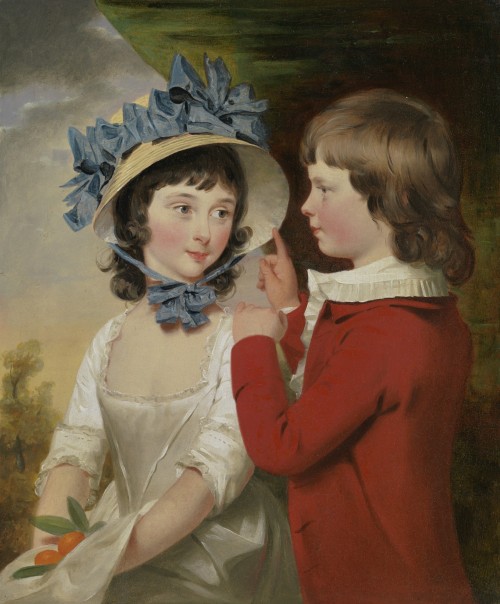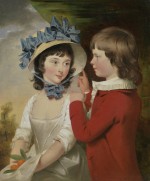JOHN DOWNMAN
Devon Ruabon, North Wales 1750 - 1824 Wrexham
Ref: BM 90
Portrait of William and Isabella Way of Denham Place, Buckinghamshire
Signed and dated lower right: J Downman / P / 1782
Oil on panel: 9 3/8 x 7 5/8 in / 23.8 x 19.4 cm
Frame size: 14 ¼ x 13 in / 36.2 x 33 cm
Provenance:
Mrs GF Baker, USA
Scott & Fowles, New York
Collection of Mr and Mrs Paul Mellon, by 1963;
the Estate of Mrs Paul Mellon
Exhibited:
Richmond, Virginia Museum of Fine Arts, Painting in England 1700-1850, Collection of Mr and Mrs Paul Mellon, 1963, no.270
John Downman is now best known for his small, oval portraits in black chalk and stump, drawn on very thin paper and tinted with watercolour on the reverse to give the effect of translucent skin tones. In the earlier part of his career, however, he often worked in oil on panel or copper. This superbly preserved double portrait reflects the economy and classical delicacy of line which Downman had developed after studying in Rome in the company of Joseph Wright of Derby from 1773-4. It also shows the sympathy and humanity which he brought to portraits of children. Downman excelled at the double-portrait format, here bringing a touching sense of familial affection. Isabella looks tenderly at her young brother as he holds forth on some enthusiasm.
The sitters were the children of Benjamin Way, Esq. (1740-1808) of Denham House, Buckinghamshire, and his wife Elizabeth Anne Cooke (1746-1825), daughter of William Cooke, Provost of King’s College, Cambridge. Downman lived in Cambridge in the mid-1770s and many of his sitters had connections with that city. The Ways had seven sons and nine daughters; Isabella was the eldest daughter, William the third son. Benjamin Way was the son of Lewis Way, a Director of the South Sea Company, and himself became a Sub-Governor of the Company and a Fellow of the Royal Society. He had a brief political career as MP for Bridport (where the family had property and connections) from 1765-8.
The present portrait derives from a chalk sketch (Fitzwilliam Museum, Cambridge), made in 1779[1]. That same year Downman drew several members of the Way family, including Mrs Way and Benjamin Way Snr (private collections)[2]. He also drew Benjamin Way’s two eldest sons, Masters Benjamin and Lewis Way (Fitzwilliam Museum)[3].
JOHN DOWNMAN, ARA
Ruabon, North Wales 1750 – 1824 Wrexham
John Downman was a fashionable portrait painter in the second half of the eighteenth century and the beginning of the nineteenth. He was born in Ruabon, North Wales, the son of Francis Downman, an attorney of Devonshire stock, and his wife Charlotte, daughter of Francis Goodsend, the private secretary to George I. In 1768 John became a pupil of Benjamin West and the following year attended the Royal Academy Schools. He showed his first portrait at the RA in 1770 and his first subject painting in 1773, exhibiting there until 1819. From 1773-4 Downman, by now married, studied in Rome in the company of Joseph Wright of Derby.
By 1777 Downman was living in Cambridge, but the following year set up a studio at Bedford Street, Covent Garden. From 1779-1804 he lived at increasingly fashionable London addresses, including Bond Street, Jermyn Street and Piccadilly. Downman painted few large-scale oil portraits, although these are elegant and accomplished. His early work is mostly small, oval oil portraits on copper, painted in the delicate manner of Francis Wheatley. Downman is most well known, however, for small, often oval portraits in black chalk and stump, tinted with watercolour. He drew on very thin paper and painted the flesh tints on the reverse, creating a subtle glow as the watercolour showed through. Downman’s soft, pretty style suited the taste of the age; he drew the foremost beauties of his day, including the Duchess of Devonshire, and was much in demand for his lively, naturalistic portraits of children. His study of classical art in Italy is apparent in his austere, delicate lines and his habit of placing sitters in cameo-like profile.
Downman made a number of subject pictures on themes from mythology, classical history, poetry and the theatre, for example The sybarite, 1805 (pencil, black chalk, watercolour and gouache; Victoria and Albert Museum, London). He contributed a scene from As You Like It (untraced) to John Boydell’s Shakespeare Gallery and in 1782 exhibited at the Royal Academy an oil painting of The return of Orestes, depicting private theatricals with the Prince of Wales as Orestes (with Messrs. A Tooth, London, in 1948). Downman became an ARA in 1795.
In 1804 Downman was living in West Malling, Kent, where he had relatives; he was a keen naturalist and made studies of animals and birds. By 1806 he had moved to Devon, where he married a daughter of the well known Exeter organist and composer William Jackson. His later years were spent in constant travel to fulfil commissions, for example to Alnwick, Northumberland, to portray Hugh, Lord Percy, son of the Duke of Northumberland. In 1818, with the decline of demand for his work, he settled in Chester; he died at his daughter’s house in Wrexham in 1824.
Downman kept volumes of sketches of his sitters in which he records lively and amusing comments about them. These volumes are now divided between the British Museum, London and the Fitzwilliam Museum, Cambridge.
The work of John Downman is represented in the Victoria and Albert Museum, London; the National Portrait Gallery, London; the British Museum, London; the Fitzwilliam Museum, Cambridge; the Yale Center for British Art, New Haven and in many English country house collections.
[1] Inv. no.1934. Downman collected his sketches into a number of volumes which he bequeathed to his daughter and which eventually came to the Fitzwilliam. The chalk drawing of William and Isabella Way is in the Second Series, vol. 5, no.12. See GC Williamson, John Downman, A.R.A., London 1907, p.liv, pl. 35 and Jane Munro, John Downman 1750-1824, Cambridge 1996, p.92.
[2] The parents’ portraits were framed separately and did not enter the Fitzwilliam collections. See Williamson, op. cit., p.lxi, no.285 (Mrs Way) and p.lxii, no.302 (Mr Way).
[3] Inv. no.1933. Second Series, vol. V, no.11.









